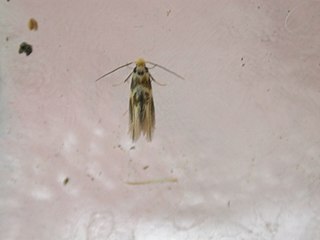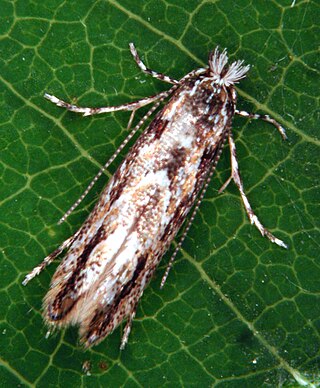
Gracillariidae is an important family of insects in the order Lepidoptera and the principal family of leaf miners that includes several economic, horticultural or recently invasive pest species such as the horse-chestnut leaf miner, Cameraria ohridella.

Bucculatrix thoracella, the lime bent-wing, is species of moth in the family Bucculatricidae, and was first described in 1794 by Carl Peter Thunberg as Tinea thoracella. It is found throughout Europe with exception of Ireland and the Balkan Peninsula, and in Japan, where it occurs on the islands of Hokkaido and Honshu.
Phyllonorycter bartolomella is a moth of the family Gracillariidae. It is endemic to the Canary Islands and is known from Gran Canaria and Tenerife.

Corythoxestis is a genus of moths in the family Gracillariidae. As with their close relatives, they are small leaf-mining moths.
Metriochroa is a genus of moths in the family Gracillariidae.
Eumetriochroa is a genus of moths in the family Gracillariidae.
Guttigera is a genus of moths in the family Gracillariidae.
Phyllonorycter cytisella is a moth of the family Gracillariidae. It is endemic to the Canary Islands and is known from Gran Canaria, La Palma, and Tenerife.
Phyllonorycter cytisifoliae is a moth of the family Gracillariidae. It is endemic to the Canary Islands and is known from Gran Canaria, La Palma, and Tenerife.

Phyllonorycter foliolosi is a moth of the family Gracillariidae. It is endemic to the Canary Islands and is known from La Palma and Tenerife.
Phyllonorycter helianthemella is a moth of the family Gracillariidae. It is found from Germany to the Iberian Peninsula, Italy and Greece and also on the Canary Islands.
Caloptilia xanthopharella is a moth of the family Gracillariidae. It is known from Australia, Fiji, the Solomon Islands, and Vanuatu.
Phyllonorycter caudasimplex is a moth from the family Gracillariidae. It is known from Nigeria.
Corythoxestis sunosei is a moth of the family Gracillariidae. It is known from Japan and China (Hunan).
Corythoxestis yaeyamensis is a moth of the family Gracillariidae. It is known from the Ryukyu Islands, Japan.
Caloptilia querci or Povolnya querci is a moth of the family Gracillariidae. It is known from Japan and Korea.
Caloptilia cruzorum is a moth of the family Gracillariidae. It is known from the Galápagos Islands (Ecuador) and from Brazil. It is named for Eliecer and Emma Cruz-Bedon for their "unwavering involvement in Galapagos conservation".
Caloptilia dondavisi is a moth of the family Gracillariidae. It is known from the Galápagos Islands (Ecuador) and from Brazil. It is named for Donald R. Davis.

Lithocolletinae is a subfamily of insects in the moth family Gracillariidae. It is distributed worldwide, with most species in temperate regions.

Gracillariinae are a subfamily of moths which was described by Henry Tibbats Stainton in 1854.





